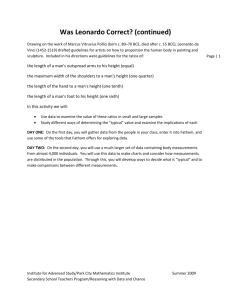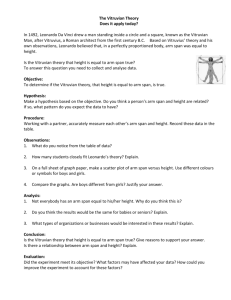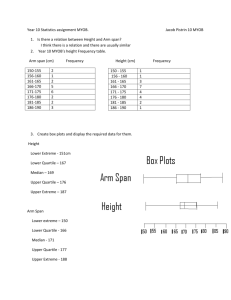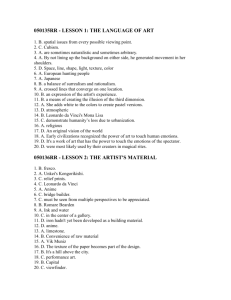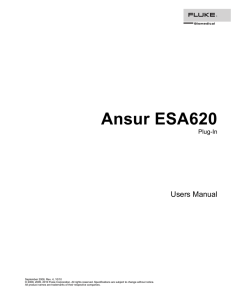Teacher Notes Was Leonardo Correct?
advertisement
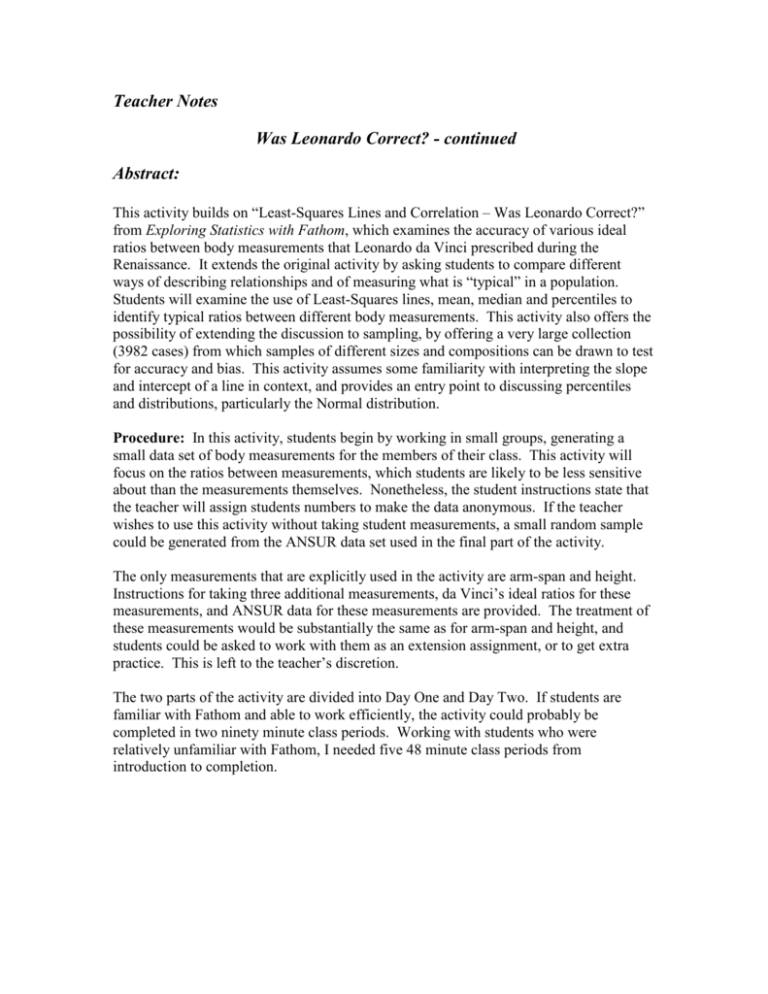
Teacher Notes Was Leonardo Correct? - continued Abstract: This activity builds on “Least-Squares Lines and Correlation – Was Leonardo Correct?” from Exploring Statistics with Fathom, which examines the accuracy of various ideal ratios between body measurements that Leonardo da Vinci prescribed during the Renaissance. It extends the original activity by asking students to compare different ways of describing relationships and of measuring what is “typical” in a population. Students will examine the use of Least-Squares lines, mean, median and percentiles to identify typical ratios between different body measurements. This activity also offers the possibility of extending the discussion to sampling, by offering a very large collection (3982 cases) from which samples of different sizes and compositions can be drawn to test for accuracy and bias. This activity assumes some familiarity with interpreting the slope and intercept of a line in context, and provides an entry point to discussing percentiles and distributions, particularly the Normal distribution. Procedure: In this activity, students begin by working in small groups, generating a small data set of body measurements for the members of their class. This activity will focus on the ratios between measurements, which students are likely to be less sensitive about than the measurements themselves. Nonetheless, the student instructions state that the teacher will assign students numbers to make the data anonymous. If the teacher wishes to use this activity without taking student measurements, a small random sample could be generated from the ANSUR data set used in the final part of the activity. The only measurements that are explicitly used in the activity are arm-span and height. Instructions for taking three additional measurements, da Vinci’s ideal ratios for these measurements, and ANSUR data for these measurements are provided. The treatment of these measurements would be substantially the same as for arm-span and height, and students could be asked to work with them as an extension assignment, or to get extra practice. This is left to the teacher’s discretion. The two parts of the activity are divided into Day One and Day Two. If students are familiar with Fathom and able to work efficiently, the activity could probably be completed in two ninety minute class periods. Working with students who were relatively unfamiliar with Fathom, I needed five 48 minute class periods from introduction to completion. Sample responses and notes on student questions: Q1 a and b: If students are using rulers or tape measures, the exact positioning of the measurement device, as well as the exact positioning of the measurer may cause small variations in the reading. For some of the measurements there may also be some variation due to the subject inhaling or exhaling. The full description for the ANSUR data set specifies that measurements be taken with calipers, and specifies where in the respiratory cycle the subject should be. If students’ reading level permits, it may be interesting to look at the official definitions together. c: This question takes a first pass at asking students to think about how to make comparisons. Students may also be surprised that perceived differences are smaller than they had thought. d: As students will discover in the last part of the activity, the average ratio of arm span to height appears to be around 1.03, with a ratio of 1 falling around the 15th percentile. Therefore, it is likely that students’ measured arm spans will all be greater than their height, although other hypotheses are possible. This activity also offers avenues to a discussion of sampling error, and student responses may naturally lead in that direction. Bubble #1: The ratio of the averages is equivalent to ratio of the sums. ∑ (s1 + s 2 + ... + s n ) This is because the ratio of the averages: n ∑ (h1 + h2 + ... + hn ) n Reduces to the ratio of the sums: = ∑ ( s1 + s 2 + ... + s n ) ∗ = ∑ (s1 + s 2 + ... + s n ) ∑ (h1 + h2 + ... + hn ) n n ∑ (h1 + h2 + ... + hn ) Bubble #2: The armspan would be “rise”, and height would be “run”. Q2 a, b, c and d: Student responses will vary. The intention here is for students to ௦௩ௗିௗ use the formula to quantify the difference. ௗ Note on regression: Teaching regression analysis is essentially about teaching students to correctly interpret results. Bivariate regression analysis often looks at the relationship between a “dependent” y-variable and an “independent” or “explanatory” x-variable. In this case, the assignment of “x” to Height and “y” to Arm-span is arbitrary – one would not say that one depends on or explains the other. Reversing the assignment of x and y would simply invert the ratio that is found in this project, and would be equally valid. The important thing is to be aware that in this situation one is making a choice, and to be consistent. This could be worthwhile to discuss with more advanced students. The choice to use a regression line in this activity was motivated by a desire to help students visualize the correlation between the two values, and to introduce this feature of Fathom. Additionally, this lesson was inspired by other published lessons that use regression lines to study the ratios of Vitruvius and da Vinci. Nonetheless, it would be possible to study the relationship using ratios calculated from the data, without using graphical tools. Q3 a: The interpretation of the slope here is that for each additional centimeter of height, we expect to observe (or we observe “on average”) an additional 1.132 (or whatever value your data produces) centimeters of arm span. b: The intercept has no meaning here – it extrapolates from the data to predict an arm span of -18.4 centimeters for an individual with height zero. Its function is simply to locate the line properly through the cloud of data points. You might want to have students rescale the axes to include the origin so that they can see how far the y-intercept lies from any of their observations. c: When the intercept is forced to zero (meaning that we force an individual with no height to also have no arm span) the slope of the line should be within a rounding error of the average ratio calculated in Q2c. Doing this seems to detract from the line’s accuracy as a predictive tool within the observed range of values, but as students will see in the last part of the activity, it gives a more accurate measure of what is typical. Q4 a and b: Student answers will vary. Certainly marketers bombard us with idealized images intended to induce a desire to consume and thereby change our own appearances. Almost of necessity, these need to be far from what is typical. Some research into Renaissance art and culture would be needed to consider whether da Vinci had any purpose beyond providing guidance. c: Student answers will vary, although they may cite age, gender or the ethnic makeup of their class as sources of difference. The ages of individuals in the ANSUR data range from 17 to 52, with a first quartile of 23. It is divided about 45%/55% between males and females, although there does not appear to be very much cross-gender difference in this attribute. The ethnic makeup is highly diverse, and the large number of different, and often overlapping, ethnicities in the original data would make it difficult to analyze the data along these lines. d: Student answers will vary. Students may say that they will be close because “one” is a good enough approximation. Encourage them to hold off on making such judgments until the end of the entire activity. DAY TWO This Fathom file contains the Leonardo ANSUR subset from the master Excel spreadsheet. Q1 a: 1.096 differs from 1 by 9.6% b: In the last activity we saw that this is equivalent to forcing the intercept of the Least-Squares line to zero. Raising the intercept while trying to keep the line as centered as possible in the cloud of data points should reduce the slope. If students have trouble intuiting this, you might expand the axes to include the origin and demonstrate with a moveable line. Q2 a: The Dot Plot is centered around roughly 1.03, with the middle ten percent of the data between 1.027 and 1.034. Student answers to the second part will vary. b: The purpose of this question is simply to have students practice using appropriate basic vocabulary for talking about distribution curves (i.e. location of center, right and left tail). If students are unfamiliar with this vocabulary, this question could provide an opportunity to introduce it. As they will learn in the next part of the activity, a ratio of 1 corresponds roughly to the 15th percentile. As the distribution here is quite close to Normal (although that is beyond the scope of this activity) this value is about halfway between the center and the narrow part of the left tail. c: Student answers will vary. d: 1.096 is in the right tail. In the next part students will figure out that this value is at the 98th percentile. Q3 a: The 50th percentile (more commonly known as the median) for this attribute is 1.0303. b: 14.85% of the collection has an arm span to height ratio below 1, so 85.15% has a ratio above 1. c: 98.2% of the collection has a ratio below 1.096, so 1.8% has a ratio greater than this. d: Student answers will vary. e: Discussing the location of the class average in this Dot Plot would be problematic, as the Dot Plot is composed of individuals – it does not represent a sampling distribution. Assuming that the ANSUR population closely resembles the general population, and assuming that your class is a random, unbiased, sample from the same population (plausible but highly questionable assumptions), the class average is more likely to fall close to the center of the distribution than is any individual in the class or in the population as a whole. Student answers will vary. The discussion in this activity lends itself most readily to students identifying either the median or a percentile range, although the distribution is more or less symmetric, making the mean very close to the median. The slope of the Least-Squares line is a highly problematic measure. 0.9759 to 1.0927 is the range for the middle 95% of the collection. Q4 Q5 Questions 6,7 and 8 are offered as extensions, to be used at the teacher’s discretion. Q6 Q7 Q8 As students repeat this process three more times, they should be encouraged to wean themselves from reference to the printed instructions. Students may not be able to find pictures of individuals posed exactly as they need to be to make the measurements precisely. Students may want to practice measuring themselves in different poses to figure out how to estimate height, arm span, etc. from photographs. Students might choose to use the averages to produce a single set of directions, and a single example of an “ideal” figure, or to provide a collection of acceptable figures based on the “typical range of values.”

